I took some video of Kay and Karl this weekend with the AR, and they both have a pretty standard flinch. Most of us have it to one degree or another, but it can be controlled with a lot of repetition and a good dose of ball'n'dummy drill.
We'll start with Karl. These four frames are from the same shot sequence, and we'll go through one by one. As always, click to embiggen:

Karl has a pretty good shooting position here. Nose is not-quite to charging handle, not dragging wood, good cheek weld, buttstock is tucked well into the shoulder... I'm not a fan of the magwell grip, but for bench shooting there's nothing terribly wrong with it.
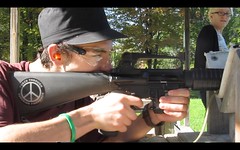
The trigger is back, the bolt is mid-recoil (on the back-stroke), and Karl's just been tapped in the nose by the charging handle. And his eyes are closing/closed.
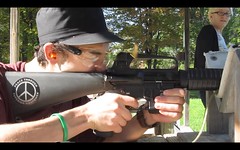
The rifle is at the back of its recoil stroke, the brass is ejected and the bolt is closed on the next cartridge - but Karl hasn't finished his recoil stroke yet. Full-on face-squinch... but wait, there's more!
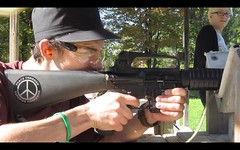
That pop in the nose from the CH was enough to break his cheek weld. His eyes are coming back open here but his cheek is off the stock still. In any kind of precision shooting, consistency from shot to shot is the key. Losing your cheek weld (and getting smacked in the nose by your rifle) is not a consistent shooting platform.
Looks like some ball'n'dummy is in Karl's immediate future!
On to Kay:
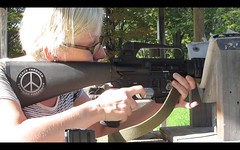
Due to vision issues, Kay doesn't sit her nose right on the charging handle. Aside from that, this isn't a bad arrangement. An A2 stock is a hair long for her - note the position of the buttstock relative to her shoulder - but that's not something I can readily fix. (An A1 stock would be a big improvement, I think. Sadly, a carbine stock isn't legal on this rifle.)

Kay has just started the trigger pull, and her eyes are already closed...
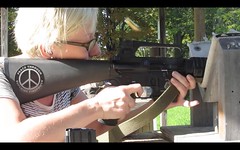
Brass ejected, bolt is back forward, and Kay's eyes are still closed. She did, however, keep her trigger back like I taught her - so it's not all bad. It's also worth noting that the stock has slipped *up* on her shoulder by a fraction of an inch, which would have the lovely effect of throwing shots low.
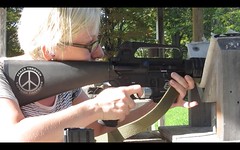
Also to her credit, Kay didn't lose her cheek weld through this whole process, meaning she was riding the recoil perfectly.
If you have new shooters - or are just curious about your own form - a video camera and tripod can be a great teaching tool. It's easy to say, "You flinched." ... it's MUCH more impressive to SHOW them their flinch.


2 comments:
Isn't it a shame that an adjustable stock is illegal in some states!
I want a M&P15-22 for fun, but also for training new shooters. But the adjustable stock is a MUST, as new shooters come in all sizes.
Fuck you Massachusetts.
BTW is nose-to-charging handle an ideal shooting position? I never looked where my beak was the last time I shot an AR/M16.
Nose-to-handle is how I shoot and what I teach, because it makes for a good index point to keep a consistent cheek weld. I've seen people put a dimple in or pimple on their stock for the same purpose.
As mentioned, consistency is key, and once your sights are zeroed for one arrangement, the closer you can stay to that the better.
Post a Comment